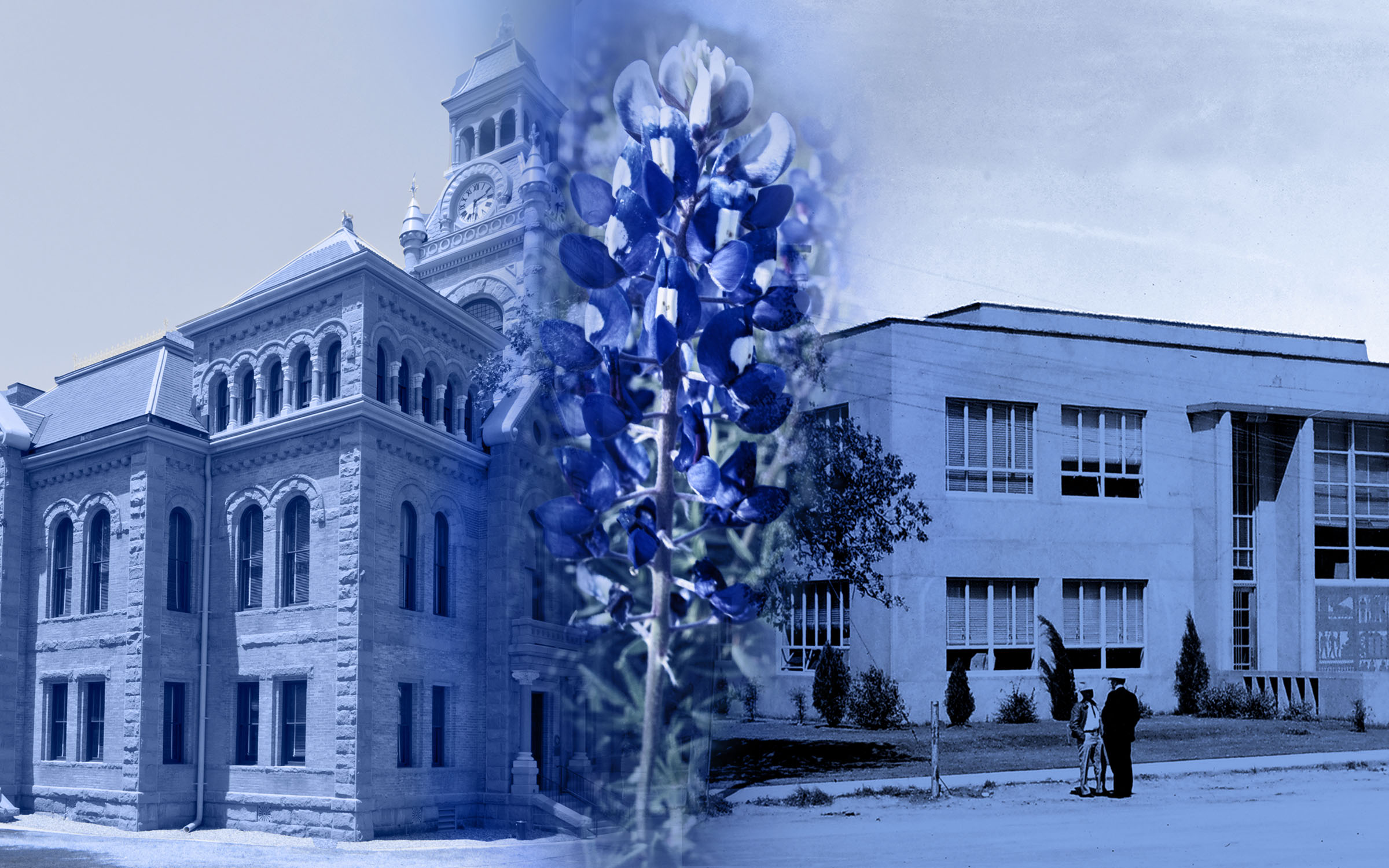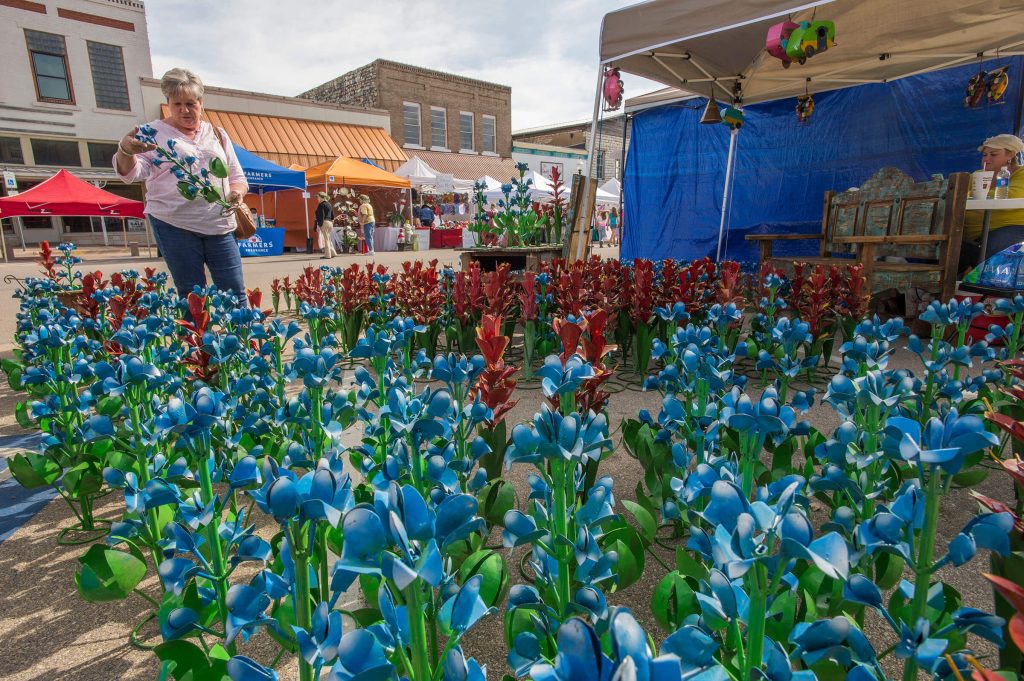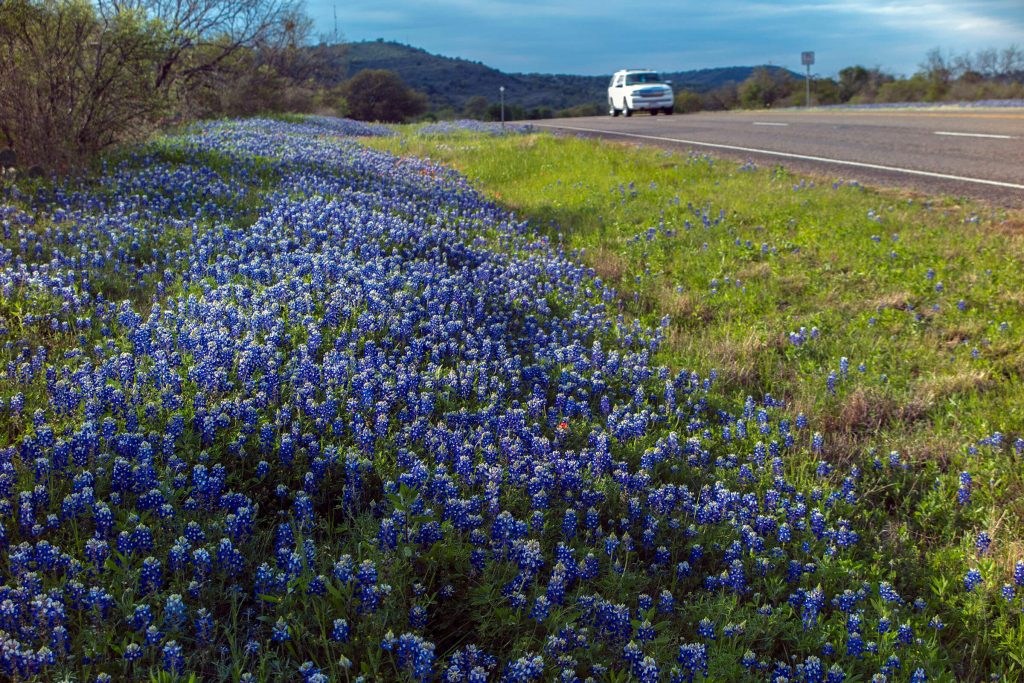
Photo by Will van Overbeek (Llano courthouse), Kevin Stillman (center), TxDOT archives (Burnet courthouse)
When the Texas Legislature focuses on bluebonnets, it can take unprecedented action, with our State Flower getting drawn into regional rivalries and larger political disputes. Such was the case in 1981 when Burnet and Llano counties were memorialized as “Bluebonnet Co-Capitals of Texas.”
It was the first time a place in Texas was designated as the “capital” of anything (other than the obvious state capital of Austin). Now, we have 89 official state capitals, ranging from Anahuac being named “Alligator Capital” in 1989 to Wills Point becoming “Bluebird Capital of Texas” in 1995. We even have a state capital for pumpjacks (Electra, designated in 2001), chess (Brownsville, 2003), and pickles (Mansfield, 2013).
The 1981 action about bluebonnets, adopted as Texas’ official flower 80 years earlier, was also the first and only time that two locations would share a “capital” imprimatur. The 2009 Legislature forbade such duplicative designations going forward, grandfathering the Burnet and Llano counties’ Bluebonnet Co-Capital resolution.
Establishing the resolution was not a certainty until the final day of the 67th Legislature on June 1, 1981, because of what former State Rep. Stan Schlueter called “petty politics.” Representing the district that included Burnet at the time, Schlueter introduced the House Resolution to honor the Hill Country town as Texas’ Bluebonnet Capital on April 20. State Sen. Lloyd Doggett of Austin proposed an identical resolution in his chamber. (“Seldom have I seen more extensive floral displays than in Burnet and the surrounding area,” says the now long-serving U.S. Representative. “Great that Burnet still celebrates in a way that justifies this distinction.”)
While Doggett’s resolution flew through the legislative process unscathed, Schlueter did not have it as easy. His seemingly innocuous resolution died in committee on May 4 for lack of a motion. Four decades later, he still suspects a legislator from another Hill Country district who sat on the committee killed the resolution because he wasn’t happy with Schlueter’s choice to succeed Rep. Bill Clayton as House Speaker.
On June 1, the Legislature’s final day, Schlueter agreed to an amendment that would change “Burnet” to “Burnet County” and add “Llano County,” even though, he says, “my guess is that Llano never asked for it.” Then, both the House and Senate had to suspend procedural rules for the amended resolution to come to the floor. It was approved on voice votes, squeezed among lengthy deliberations about licensing of podiatrists, dentists, and optometrists and other actions.
The amended resolution declared: “Central Texas is especially noted for its resplendent array of bluebonnets, and Burnet and Llano counties, local on the Highland Lakes Bluebonnet Trail, offer visitors the dazzling sight of countless fields covered with a profusion of bluebonnets.”

Burnet’s Bluebonnet Festival takes place every April. Photo by Michael Amador
This spring, that definitely is the case for the State Flower. “It’s one of the best years to see them; they are in full bloom throughout Burnet and the Hill Country,” says Allison McKee, executive director of the Burnet Chamber of Commerce, as Burnet prepares for its 40th annual Bluebonnet Festival this weekend. As many as 35,000 people are expected to attend parades, a wildflower show, arts and craft booths, live music, a gunfighter shoot-out, wiener dog race and demolition derby.
Burnet takes great pride in its status as “one of the best places in Texas for viewing wildflowers,” as the festival’s magazine boasts. It goes on to say, “The town officially gained recognition to the well-known fact in 1981, when the Texas State Legislature officially designated Burnet the ‘Bluebonnet Capital of Texas.’” That assertion, of course, is at odds with the 67th Legislature’s final action about Burnet and Llano counties being co-capitals.
Meanwhile, Llano County’s official bluebonnet status is less well promoted. Llano’s 2022 visitor’s guide (found on the Llano Chamber of Commerce’s homepage) refers briefly to the town being “The Bluebonnet Capital” and a Facebook post with a TikTok video is captioned: “Do you know this happened in 1981? Bluebonnet Co-Capital of Texas.” Instead of a formal bluebonnet-themed event, Llano County’s tourism site offered a wildflower update this year, with directions for best sightseeing venues. Otherwise, the community celebrates its annual crawfish festival the third Friday and Saturday of April, and the Llano Chamber of Commerce, referring to Llano as “The Deer Capital of Texas,” throws a party for hunters the Friday before deer season opens.
Now, before you think only the Hill Country embraces the bluebonnet, Ennis in North Texas and Chappell Hill near Brenham in the Prairies and Lakes region of the state also hold bluebonnet festivals in April. Ennis is Texas’ official Bluebonnet City, and Chappell Hill hosts the state’s official Bluebonnet Festival. Similar to lawmakers’ deliberations about Burnet and bluebonnets, the original 1997 resolution, filed as an official state symbol and solely on Chappell Hill’s behalf, was later amended to include the official city honor for Ennis and, for good measure, give Ennis the additional distinction of having the official State Bluebonnet Trail. It was a departure of legislative protocol for different symbols to be merged in a single resolution.

Roadside wildflowers in Llano County. Photo by Kevin B. Stillman
Now, these are not the only times bluebonnets have caused a stink. Back in 1901, bluebonnets set their first precedent in Texas governance with the establishment of the Official State Flower. It was the first official state symbol to be enacted and, like Bluebonnet Co-Capitals, it was contested—the other candidates being the more commercially viable cotton boll and the distinctive “tuna” bloom on the prickly pear. Even then, the bluebonnet battle wasn’t over until 1971, when the Legislature relented to identify two more bluebonnet species and “any other variety of bluebonnet not heretofore recorded” as Texas’ state flower.
Back to co-capitals, leave it to Chet Garner, better known as the Daytripper and a contributing writer to Texas Highways, to get it right when others haven’t. His Ultimate Bluebonnet Road Trip, “bursting with bluebonnets along the highways,” starts in Burnet and heads on State Highway 29 to Llano before turning south on State Highway 16 toward Fredericksburg, calling attention to Burnet and Llano counties as “Bluebonnet Co-capitals.”
Garner views the compromise on Texas’ bluebonnet co-capitals as “collaboration at its best,” concluding “what’s good for one is good for the other.” He suggests: “In days past, who deserves the official title might have been settled in a gun fight across county lines…But, instead of spilling red on the fields of Texas, the counties decided to work together and spill blue anywhere and everywhere.”








